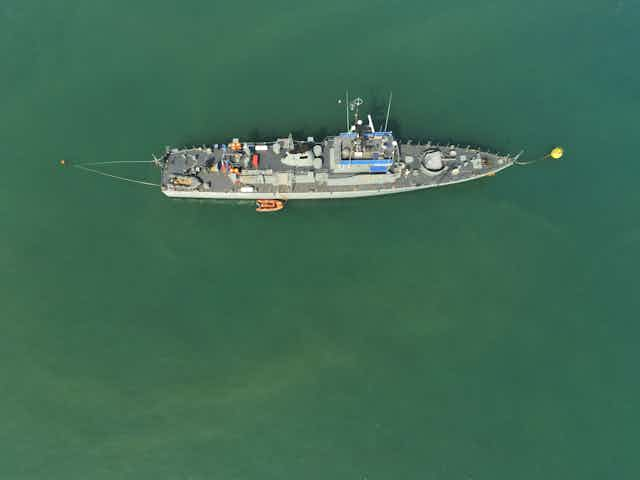The Gulf of Guinea – a coastal region that stretches from Senegal to Angola – is endowed with vast reserves of hydrocarbon, mineral and fisheries resources. It is also an important route for international commerce, making it critical to the development of countries in the region.
For a long time, however, countries in the Gulf of Guinea haven’t properly monitored what’s happening in their waters. This has allowed security threats at sea to flourish. The threats include illegal, unreported and unregulated fishing, drug trafficking, piracy and armed robbery, and toxic waste dumping.
For instance, in 2020, the International Maritime Bureau reported that the region had experienced the highest number of crew kidnappings ever recorded: 130 crew members taken in 22 incidents. In 2019, 121 crew members were kidnapped in 17 incidents.
Regional action to address these threats is being taken. In 2013, heads of state signed the Yaoundé Code of Conduct – a declaration to work together and address the threats. This also involved setting up a large hub, known as the Yaoundé Architecture (made up of different divisions), which coordinates and shares information on what’s happening at sea.
Since the Yaoundé Code of Conduct was signed in 2013, there has been some progress. As we found in a new study, tech-driven tools have been playing a vital role in addressing security threats at sea in west and central African countries.
For instance, Nigeria was once designated a piracy hotspot but, in 2022, was delisted. This was in large part due to the use of technology.
Tech tools have helped countries to more efficiently manage and monitor the marine environment. They also support information sharing among law enforcement agencies. This has led to successful interdictions and enabled the prosecution of pirates in the region.
The tech tools
Cargo and fishing vessels are required, under international law, to be fitted with systems that transmit data showing where they are.
Since the signing of the Yaoundé Code of Conduct, we found that new technology is now using this location data to help countries in the Gulf of Guinea monitor their waters.
Tools and systems – like Radar, Yaoundé Architecture Regional Information System (Yaris), Sea-Vision, Skylight and Global Fishing Watch – are integrating information from various surveillance and location monitoring systems and satellite data to identify suspicious behaviour. This has significantly helped to improve efforts to combat security threats.
Countries in the Gulf now have increased awareness of vessel activity in their waters and are able to make more informed responses in emergencies, like piracy or armed robbery and oil theft.
For instance, in 2022 the Heroic Idun tanker, evaded arrest in Nigeria for suspicious behaviour, then travelled on to Equatorial Guinea. Using the Yaoundé Architecture system, Equatorial Guinea held the vessel at Nigeria’s request and it was later fined.
Without the Yaoundé Code of Conduct, and the new tech that it has introduced, the sharing of information, capture of evidence and cooperation between countries would not have been possible.
Nigeria’s tech advancements
Nigeria is a prime example of a country where investment in technology-based infrastructure has helped it to tackle threats to security and development.
Over the past three years, Nigeria has deployed a range of tech tools. For instance, the navy deployed the Regional Maritime Awareness Capability facility, which receives, records and distributes data and the mass surveillance FALCON EYE system.
The Nigerian Maritime Administration and Safety Agency has also made advancements through its Deep Blue Project. This includes a central intelligence and data collection centre which works with special mission vessels (like unmanned aerial vehicles) to take action against threats.
Nigeria has since had a reduction in piracy and armed robbery at sea. Once designated a piracy hotspot, the country was delisted as a hotspot in 2022.
Cautious optimism
Evidently, technology has an important role to play in enhancing safety and security at sea. But it’s not without it’s challenges, as we identified in our study.
First, an over-reliance on external tech tools has resulted in a lack of ownership of the technology. This affects the sustainability of the projects. For instance, once EU funding for YARIS expires, the operating costs will be transferred from the EU to Yaoundé Architecture states. But there are still no clear plans from regional states on how to sustain YARIS.
Second, people with specific expertise are needed to use the tech. But many countries can’t afford to hire them, or aren’t producing human resources with this expertise. Even when personnel have received training, they may not have access to the tools (which aren’t available at the country level) to apply what they have learnt.
Third, existing monitoring systems such as AIS and VMS can be switched off, a vulnerability that criminals continue to exploit. Radar systems can fill these gaps, but there’s a lack of RADAR coverage along coastlines. Related to this, the scarcity of national data centres for long range vessel identification and tracking (due to lack of investment) makes using existing technology difficult.
Fifth, there are challenges related to communication difficulties, the absence of internet connections onboard some vessels or low internet speed.
Finally, private operators like the shipping industry aren’t using the services provided by the Yaoundé Architecture. This smacks of politics and lack of trust in the regional solutions.
Vessel operators report incidents instead to agencies outside the region, such as Maritime Domain Awareness for Trade - Gulf of Guinea (based in France) or the International Maritime Bureau in Malaysia and these agencies often broadcast the information without confirming with the regional architecture. This undermines the ability of regional agencies to do their work effectively.
It’s in the best interests of Atlantic nations to cooperate and coordinate on meeting maritime security challenges.
Technology can play a key role in this. But it’s vital that countries enhance technological know-how, and ensure that external partners and businesses use the available technological services. This will be a big step towards a secure and collaborative maritime environment.

